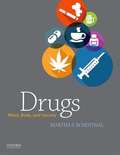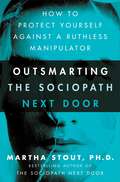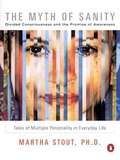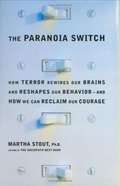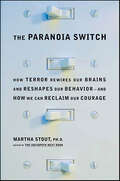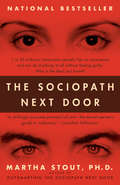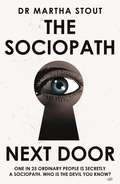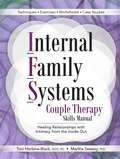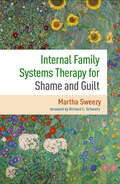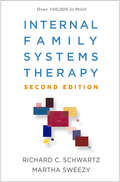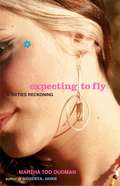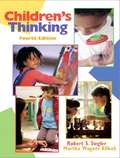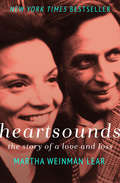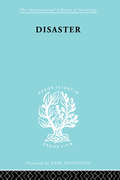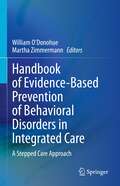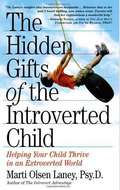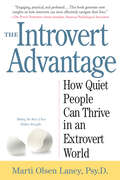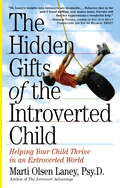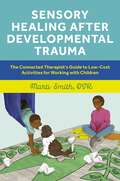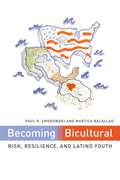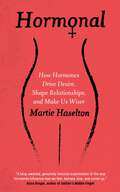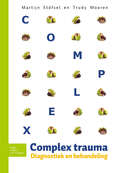- Table View
- List View
Drugs: Mind, Body, and Society
by Martha RosenthalWritten in a contemporary and accessible voice, Drugs: Mind, Body, and Society offers more than knowledge and study skills. It is a multidisciplinary text that provides students with a comprehensive discussion about drugs and drug effects that weaves together physiology, neuroscience, pharmacology, psychology, society, culture, media, history, law, and religion. With an emphasis on critical thinking skills, this book teaches students to evaluate research, assess sources of data, and discern fact from opinion, so that they can make intelligent decisions that improve the quality of their lives. <P><P>FEATURES *"Thinking Critically About Drugs," a separate section at the start of the book, teaches students how to evaluate data, validate sources, and understand how drug research is conducted *True/False chapter-opening questions, with answers, draw students into the material by asking them provocative questions that challenge commonly held misconceptions about drugs *"Critical Evaluations" in most chapters delve into controversial topics and teach students to evaluate research and information from multiple perspectives *"Ask Yourself" questions encourage students to reflect on and discuss their own ideas about the chapter material *"Quick Hits" scattered throughout each chapter provide students with brief, interesting anecdotes or fun facts from various disciplines, like history and economics *"The Straight Dope" boxes feature historical and biographical profiles, cases, self-knowledge tests, and points of clinical or cultural relevance
Modes of Therapeutic Action
by Martha StarkHow do we position ourselves, moment by moment, in relation to our patients and how do these positions inform both what we come to know about our patients and how we intervene? Do we participate as neutral object, as empathic self-object, or as authentic subject? Do we strive to enhance the patient's knowledge, to provide a corrective experience, or to work at the intimate edge? In an effort to answer these and other clinically relevant questions about the process of psychotherapeutic change, Martha Stark has developed a comprehensive theory of therapeutic action that integrates the interpretive perspective of classical psychoanalysis. <p><p> <p>•Model 1, the corrective-provision perspective of self psychology and those object relations theories emphasizing the internal 'absence of good' <p>•Model 2, and the relational perspective of contemporary psychoanalysis and those object relations theories emphasizing the internal 'presence of bad' <p>•Model 3. Model I is about knowledge and insight. It is a one-person psychology because its focus is on the patient and the internal workings of her mind. Model 2 is about corrective experience. It is a one-and-a-half-person psychology because its emphasis is not so much on the relationship per se, but on the filling in of the patient's deficits by way of the therapist's corrective provision; what ultimately matters is not who the therapist is, but, rather, what she can offer. Model 3 is about relationship, the real relationship. It is a two-person psychology because its focus is on patients and therapists who relate to each other as real people; it is about mutuality, reciprocity, and intersubjectivity. Whereas Model 2 is about 'give' and involves the therapist's bringing the best of who she is into the room, Model 3 is about 'give-and-take' and involves the therapist's bringing all of who she is into the room. <p><p>As Dr. Stark repeatedly demonstrates in numerous clinical vignettes, the three modes of therapeutic action, knowledge, experience, and relationship are not mutually exclusive but mutually enhancing. If, as therapists, we can tolerate the necessary uncertainty that comes with the recognition that there is an infinite variety of possibilities for change, then we will be able to enhance the therapeutic potential of each moment and optimize our effectiveness as clinicians.
Outsmarting the Sociopath Next Door: How to Protect Yourself Against a Ruthless Manipulator
by Martha StoutFrom Dr. Martha Stout's influential work The Sociopath Next Door, we learned how to identify a sociopath. Now she tells us what we actually can do about it.While the best way to deal with a sociopath is to avoid him or her entirely, sometimes circumstance doesn't allow for that. What happens when the time comes to defend yourself against your own child, a ruthless ex-spouse, a boss or another person in power? Using the many chilling and often heartbreaking emails and letters she has received over the years, Dr. Martha Stout uncovers the psychology behind the sociopath's methods and provides concrete guidelines to help navigate these dangerous interactions. Organized around categories such as destructive narcissism, violent sociopaths, sociopathic coworkers, sociopathy in business and government, and the sociopath in your family, Outsmarting the Sociopath Next Door contains detailed explanation and commentary on how best to react to keep the sociopath at bay. Uniting these categories is a discussion of changing psychological theories of personality and sociopathy and the enduring triumph of conscience over those who operate without empathy or concern for others. By understanding the person you're dealing with and changing the rules of the game, you'll be able to gain the upper hand and escape the sociopath's influence. Whether you're fighting a custody battle against a sociopathic ex or being gaslighted by a boss or coworker, you'll find hope and help within these pages. With this guide to disarming the conscienceless, Dr. Stout provides an incisive new examination of human behavior and conceptions of normality, and gives readers the tools needed to protect themselves.
Outsmarting the Sociopath Next Door: How to Protect Yourself Against a Ruthless Manipulator
by Martha StoutFrom Dr. Martha Stout's influential work The Sociopath Next Door, we learned how to identify a sociopath. Now she tells us what to actually do about it.While the best way to deal with a sociopath is to avoid them entirely, sometimes circumstance doesn't allow for that. What happens when the time comes to defend yourself against your own child, a boss, or ruthless ex-spouse? Inspired by the many chilling and often heartbreaking emails and letters she has received over the years, from her work with the victims of sociopathy, Dr. Martha Stout uncovers the psychology behind the sociopath's methods and provides concrete guidelines to help navigate these dangerous interactions. Organized around categories such as destructive narcissism, violent sociopaths, sociopathic coworkers, and the sociopath in your family, Outsmarting the Sociopath Next Door contains detailed explanation and commentary on how best to react in these situations to keep the sociopath at bay. Uniting these categories is a discussion of changing psychological theories of personality and sociopathy and the enduring triumph of conscience over those who operate without empathy or concern for others. By understanding the person you're dealing with and changing the rules of the game, you'll be able to gain the upper hand and escape the sociopath's influence.Whether you're fighting a custody battle against a sociopathic ex or being gaslighted by a boss or coworker, you'll find hope and help within these pages. With this guide to disarming the conscienceless, Dr. Stout aims to give readers the tools to protect themselves while conducting a broader examination of human behavior and conceptions of normality.
The Myth of Sanity
by Martha StoutWhy does a gifted psychiatrist suddenly begin to torment his own beloved wife? How can a ninety-pound woman carry a massive air conditioner to the second floor of her home, install it in a window unassisted, and then not remember how it got there? Why would a brilliant feminist law student ask her fiancé to treat her like a helpless little girl? How can an ordinary, violence-fearing businessman once have been a gun-packing vigilante prowling the crime districts for a fight? A startling new study in human consciousness, The Myth of Sanityis a landmark book about forgotten trauma, dissociated mental states, and multiple personality in everyday life. In its groundbreaking analysis of childhood trauma and dissociation and their far-reaching implications in adult life, it reveals that moderate dissociation is a normal mental reaction to pain and that even the most extreme dissociative reaction-multiple personality-is more common than we think. Through astonishing stories of people whose lives have been shattered by trauma and then remade, The Myth of Sanityshows us how to recognize these altered mental states in friends and family, even in ourselves. "We only think we're sane, says this Harvard psychologist. . . . The befuddled, normally sane masses can learn a lot from the victims of grave psychological abuse. " (The Dallas Morning News)
The Paranoia Switch: How Terror Rewires Our Brains and Reshapes Our Behavior--and How We Can Reclaim Our Courage
by Martha StoutOn September 11, 2001, the "Fear Switch" in our brains got flicked. How do we turn it off and reclaim our lives? Five years after September 11, we're still scared. And why not? Terrorists could strike at any moment. Our country is at war. The polar caps are melting. Hurricanes loom. We struggle to control our fear so that we can go about our daily lives. Our national consciousness has been torqued by trauma, in the process transforming our behavior, our expectations, our legal system. In The Myth of Sanity, Martha Stout, who until recently taught at the Harvard Medical School, analyzed how we cope with personal trauma. In her national bestseller The Sociopath Next Door, she showed how to avoid suffering psychological damage at the hands of others. Now, in The Paranoia Switch,she offers a groundbreaking clinical, neuropsychological, and practical examination of what terror and fear politics have done to our minds, and to the very biology of our brains. In this timely and essential book, Stout assures us that we can interrupt the cycle of trauma and look forward to a future free of fear only by understanding our own paranoia--and what flips the paranoia switch.
The Paranoia Switch: How Terror Rewires Our Brains and Reshapes Our Behavior—and How We Can Reclaim Our Courage
by Martha StoutOn September 11, 2001, the "Fear Switch" in our brains got flicked. How do we turn it off and reclaim our lives?Five years after September 11, we're still scared. And why not? Terrorists could strike at any moment. Our country is at war. The polar caps are melting. Hurricanes loom. We struggle to control our fear so that we can go about our daily lives. Our national consciousness has been torqued by trauma, in the process transforming our behavior, our expectations, our legal system. In The Myth of Sanity, Martha Stout, who until recently taught at the Harvard Medical School, analyzed how we cope with personal trauma. In her national bestseller The Sociopath Next Door, she showed how to avoid suffering psychological damage at the hands of others. Now, in The Paranoia Switch, she offers a groundbreaking clinical, neuropsychological, and practical examination of what terror and fear politics have done to our minds, and to the very biology of our brains. In this timely and essential book, Stout assures us that we can interrupt the cycle of trauma and look forward to a future free of fear only by understanding our own paranoia—and what flips the paranoia switch.
The Sociopath Next Door: The Ruthless versus the Rest of Us
by Martha StoutWho is the devil you know? <P><P> Is it your lying, cheating ex-husband? Your sadistic high school gym teacher? Your boss who loves to humiliate people in meetings? The colleague who stole your idea and passed it off as her own? <P> In the pages of The Sociopath Next Door, you will realize that your ex was not just misunderstood. He's a sociopath. And your boss, teacher, and colleague? They may be sociopaths too. <P> We are accustomed to think of sociopaths as violent criminals, but inThe Sociopath Next Door, Harvard psychologist Martha Stout reveals that a shocking 4 percent of ordinary people--one in twenty-five--has an often undetected mental disorder, the chief symptom of which is that that person possesses no conscience. He or she has no ability whatsoever to feel shame, guilt, or remorse. One in twenty-five everyday Americans, therefore, is secretly a sociopath. They could be your colleague, your neighbor, even family. And they can do literally anything at all and feel absolutely no guilt. <P> How do we recognize the remorseless? One of their chief characteristics is a kind of glow or charisma that makes sociopaths more charming or interesting than the other people around them. They're more spontaneous, more intense, more complex, or even sexier than everyone else, making them tricky to identify and leaving us easily seduced. Fundamentally, sociopaths are different because they cannot love. Sociopaths learn early on to show sham emotion, but underneath they are indifferent to others' suffering. They live to dominate and thrill to win.<P> The fact is, we all almost certainly know at least one or more sociopaths already. Part of the urgency in reading The Sociopath Next Door is the moment when we suddenly recognize that someone we know--someone we worked for, or were involved with, or voted for--is a sociopath. But what do we do with that knowledge? To arm us against the sociopath, Dr. Stout teaches us to question authority, suspect flattery, and beware the pity play. Above all, she writes, when a sociopath is beckoning, do not join the game. <P> It is the ruthless versus the rest of us, and The Sociopath Next Door will show you how to recognize and defeat the devil you know.
The Sociopath Next Door: The Ruthless versus the Rest of Us
by Martha StoutWHO IS THE DEVIL YOU KNOW? Is it your lying, cheating ex-husband?Your sadistic high school gym teacher?Your boss who loves to humiliate people in meetings?The colleague who stole your idea and passed it off as her own?In the pages of The Sociopath Next Door, you will realize that your ex was not just misunderstood. He's a sociopath. And your boss, teacher, and colleague? They may be sociopaths too.We are accustomed to think of sociopaths as violent criminals, but in The Sociopath Next Door, Harvard psychologist Martha Stout reveals that a shocking 4 percent of ordinary people- 1 in 25 - has an often undetected mental disorder, the chief symptom of which is that that person possesses no conscience. He or she has no ability whatsoever to feel shame, guilt, or remorse. One in 25 everyday people, therefore, is secretly a sociopath. They could be your colleague, your neighbour, even family. And they can do literally anything at all and feel absolutely no guilt.How do we recognize the remorseless? One of their chief characteristics is a kind of glow or charisma that makes sociopaths more charming or interesting than the other people around them. They're more spontaneous, more intense, more complex, or even sexier than everyone else, making them tricky to identify and leaving us easily seduced. Fundamentally, sociopaths are different because they cannot love. Sociopaths learn early on to show sham emotion, but underneath they are indifferent to others' suffering. They live to dominate and thrill to win.The fact is, we all almost certainly know at least one or more sociopaths already. Part of the urgency in reading The Sociopath Next Door is the moment when we suddenly recognize that someone we know - someone we worked for, or were involved with, or voted for - is a sociopath. But what do we do with that knowledge? To arm us against the sociopath, Dr Stout teaches us to question authority, suspect flattery, and beware the pity play. Above all, she writes, when a sociopath is beckoning, do not join the game.It is the ruthless versus the rest of us, and The Sociopath Next Door will show you how to recognize and defeat the devil you know.
Internal Family Systems Couple Therapy Skills Manual: Healing Relationships with Intimacy From the Inside Out
by Toni Herbine-Blank Martha SweezyYou can help even the most conflicted, disconnected couples restore and heal their relationship. IFS Couple Therapy Skills Manual presents clinicians with a powerful, non-pathologizing approach to helping couples better understand themselves, their differences, and the underlying reasons for their suffering. Working from the lens of Intimacy from the Inside Out (IFIO) – a branch of Internal Family Systems (IFS) therapy – the authors provide a highly successful therapy that allows couples to feel understood, to decrease shame, and to reestablish loving connections. Inside you’ll find: - Step-by-step techniques - Case examples - Experiential exercises - Clear treatment explanations - Downloadable worksheets
Internal Family Systems Therapy for Shame and Guilt
by Martha SweezyRich in clinical examples, this book offers a fresh perspective on the roles of shame and guilt in psychological distress and presents a step-by-step framework for treatment. Martha Sweezy explains how the principles of Internal Family Systems (IFS) therapy are ideally suited to helping trauma survivors and other clients who struggle with debilitating shame to understand and heal psychic parts wounded in childhood. Annotated case illustrations show and explain IFS techniques in action. Other useful features include boxed therapeutic exercises, decision trees, and pointers to help therapists avoid or overcome common pitfalls.
Internal Family Systems Therapy, Second Edition (Guilford Family Therapy Ser.)
by Richard C. Schwartz Martha SweezyNow significantly revised with over 70% new material, this is the authoritative presentation of Internal Family Systems (IFS) therapy, which is taught and practiced around the world. IFS reveals how the subpersonalities or "parts" of each individual's psyche relate to each other like members of a family, and how--just as in a family--polarization among parts can lead to emotional suffering. IFS originator Richard Schwartz and master clinician Martha Sweezy explain core concepts and provide practical guidelines for implementing IFS with clients who are struggling with trauma, anxiety, depression, eating disorders, addiction, and other behavioral problems. They also address strategies for treating families and couples. IFS therapy is listed in SAMHSA's National Registry of Evidence-Based Programs and Practices. New to This Edition *Extensively revised to reflect 25 years of conceptual refinement, expansion of IFS techniques, and a growing evidence base. *Chapters on the Self, the body and physical illness, the role of the therapist, specific clinical strategies, and couple therapy. *Enhanced clinical utility, with significantly more "how-to" details, case examples, and sample dialogues. *Quick-reference boxes summarizing key points, and end-of-chapter summaries.
Expecting to Fly
by Martha Tod DudmanDO YOU REMEMBER WHAT IT FELT LIKE TO BE FIFTEEN? MARTHA TOD DUDMAN DOES. It starts with a blue hash pipe in a shabby field and a hot, tight dance at the Mayflower Hotel, and rapidly accelerates against the kaleidoscopic backdrop of the Sixties. Describing a time weirdly similar to today, Expecting to Fly recalls a conservative government embroiled in an increasingly unpopular war, racial tensions, and a generation of disillusioned young people looking for something meaningful to believe in -- teenagers who, like Dudman, hurled themselves into a sea of drugs and sex they weren't really ready for. With the same passion and brutal honesty that she brought to her first book, Augusta, Gone -- the story of her daughter's troubled adolescence -- Dudman re-creates her own wild ride through the turbulent Sixties, vividly recounting scenes you probably experienced yourself. From the prim tradition of a posh girls' school and debutante parties of Washington, D.C., to the snows of New Hampshire and the campaign for Eugene McCarthy, from living out of a knapsack in Spain to getting stoned on acid in Yellow Springs, Ohio, Expecting to Fly takes us on a blistering trip to a time when the only thing you couldn't be was shocked. Now, years later, Dudman reflects on that time and what it means: "Which was it -- triumph, exploration, some important journey, or just a big stupid mistake, a total waste of time?" You decide.
Children's Thinking
by Robert S. Siegler Martha Wagner AlibaliThis book offers a unified account of the major research findings and theories on the development of children's thinking from infancy to adolescence; and also considers their practical implications. It examines the change processes through which development occurs, as well as the nature of the changes in language, perception, memory, conceptual understanding, and problem-solving that mark cognitive development. Eight central themes presented in the first chapter integrate and unify the presentation. The authors examine Piaget's theory of development, information-processing theories of development, sociocultural theories, perceptual development, language development, memory development, conceptual development, problem solving, social cognition and the development of academic skills. For anyone involved in the thinking processes and development of children.
Heartsounds: The Story of a Love and Loss
by Martha Weinman LearThe national bestseller and undying testament of a wife&’s love for her husband as he embarks on the fight of his life. On a story assignment in France for the New York Times Magazine, Martha Weinman Lear has just escaped tourist-infested Cannes for a quiet pension in the hills behind the Riviera when she gets the call from New York. Her husband has suffered a massive heart attack and is in the hospital. Harold Lear, a fifty-three-year-old urologist and leader in the field of human sexuality research, suddenly finds himself in the helpless role of the patient. Ripping into the Lears&’ lives and marriage, Hal&’s coronary disease sends them on a journey through New York City&’s medical maze. With bittersweet poignancy, Lear chronicles her husband&’s valiant efforts to combat his sickness as more heart attacks and devastating postsurgical complications befall him. A stunning work of medical drama and journalism, Heartsounds is above all the gripping story of a passionate, enduring love.
Disaster: A Psychological Essay (International Library of Sociology)
by Martha WolfensteinFirst Published in 1998. Routledge is an imprint of Taylor & Francis, an informa company.
Handbook of Evidence-Based Prevention of Behavioral Disorders in Integrated Care: A Stepped Care Approach
by William O’Donohue Martha ZimmermannThis handbook is a comprehensive, authoritative and up-to-date source on prevention technologies specifically for integrated care settings. It covers general issues related to prevention including the practical issues of financing, and staffing, and a general introduction to the advantages of prevention efforts. It covers a range of behavioral health disorders using an approach that is most relevant to the practitioner: it provides basic definitions, and describes the specific roles of both the primary care provider (PCP) and the behavioral care provider (BCP) as well as specific resources presented in a stepped care model. Stepped care has been used sucessfully in medical settings. Adapted to behavioral health settings, It allows the clinician and the patient to choose treatments that are tailored to specific levels of intensity. This handbook is an interdisciplinary resource useful for classes in integrated care as well as for clinicians employed in in these settings.
The Hidden Gifts Of The Introverted Child: Helping Your Child Thrive In An Extroverted World
by Marti Olsen LaneyIntroverted children are often misunderstood, even by their parents, who worry about them. Engaged by their interior world, they're often regarded as aloof. Easily overwhelmed by too much stimulation, they can be seen as unmotivated. Content with just one or two close friends, they may be perceived as unpopular. Parents fret that they are unhappy and maladjusted. But the truth is quite different: Introverted children are creative problem solvers. Introverted children love to learn. Introverted children have a high EQ (emotional IQ) and are in touch with their feelings. They take time to stop and smell the roses, and they enjoy their own company. They are dependable, persistent, flexible, and lack vanity. How can parents help their introverted children discover and cultivate these wonderful gifts? Help is here. Written by Dr. Marti Olsen Laney, author of The Introvert Advantage with 74,000 copies in print, The Hidden Gifts of the Introverted Child fully explains introversion as a hardwired temperament, not a disability, and tells just what parents need to do to help their child become the person he or she is meant to be--and succeed in an extroverted world. Beginning with a 30-question quiz that places a child on the introvert/extrovert continuum, The Hidden Gifts shows parents how to foster a climate that allows introverted kids to discover their inner strengths; schedule ways for a very young innie to recharge those batteries and teach an older child to do it for him- or herself; create a harmonious household with siblings, and parents, of different temperaments; help innies find success at school, sports, parties, and other group activities.
The Introvert Advantage: Making The Most Of Your Inner Strengths
by Psy. D. Marti Olsen LaneyAt least one out of four people prefers to avoid the limelight, tends to listen more than they speak, feels alone in large groups, and requires lots of private time to restore their energy. They're introverts, and here is the book to help them boost their confidence while learning strategies for successfully living in an extrovert world. <P><P> After dispelling common myths about introverts-they're not necessarily shy, aloof, or antisocial--The Introvert Advantage explains the real issues. Introverts are hardwired from birth to focus inward, so outside stimulation-chitchat, phone calls, parties, office meetings-can easily become "too much." <P> The Introvert Advantage dispels introverts' belief that something is wrong with them and instead helps them recognize their inner strengths-their analytical skills, ability to think outside the box, and strong powers of concentration. It helps readers understand introversion and shows them how to determine where they fall on the introvert/extrovert continuum. It provides tools to improve relationships with partners, kids, colleagues, and friends, offering dozens of tips, including 10 ways to talk less and communicate more, 8 ways to showcase your abilities at work, how to take a child's temperament temperature, and strategies for socializing. Finally, it shows how to not just survive, but thrive-how to take advantage of the introvert's special qualities to create a life that's just right for the introvert temperament, to discover new ways to expand their energy reserves, and even how, when necessary, to confidently become a temporary extrovert.
The Hidden Gifts of the Introverted Child: Helping Your Child Thrive in an Extroverted World
by Marti Olsen Laney Psy.D.Introverted children are often misunderstood, even by their parents, who worry about them. Engaged by their interior world, they’re often regarded as aloof. Easily overwhelmed by too much stimulation, they can be seen as unmotivated. Content with just one or two close friends, they may be perceived as unpopular. Parents fret that they are unhappy and maladjusted. <P><P>But the truth is quite different: Introverted children are creative problem solvers. Introverted children love to learn. Introverted children have a high EQ (emotional IQ) and are in touch with their feelings. They take time to stop and smell the roses, and they enjoy their own company. They are dependable, persistent, flexible, and lack vanity. How can parents help their introverted children discover and cultivate these wonderful gifts? Help is here. Written by Dr. Marti Olsen Laney, author of The Introvert Advantage with 74,000 copies in print, The Hidden Gifts of the Introverted Child fully explains introversion as a hardwired temperament, not a disability, and tells just what parents need to do to help their child become the person he or she is meant to be—and succeed in an extroverted world. <P>Beginning with a 30-question quiz that places a child on the introvert/extrovert continuum, The Hidden Gifts shows parents how to foster a climate that allows introverted kids to discover their inner strengths; schedule ways for a very young innie to recharge those batteries and teach an older child to do it for him- or herself; create a harmonious household with siblings, and parents, of different temperaments; help innies find success at school, sports, parties, and other group activities.
Sensory Healing after Developmental Trauma: The Connected Therapist’s Guide to Low-Cost Activities for Working with Children
by Marti SmithIn using this resourceful guide, therapists can develop a comprehensive understanding of how trauma impacts their young clients' brains and sensory systems. Filled with therapeutic strategies and activities tailored to specific regions of the brain, professionals will be able to optimise brain rehabilitation and improve sensory processing abilities.The book includes a wide range of low-cost, budgeted activities that can be applied in a variety of settings, including juvenile justice, rehab, schools, homes, residential care, and foster homes, all of which include guidance on how to engage the wider community in order to maximise the potential for healing.Complete with the latest research on trauma and real-life case studies, this book provides an excellent foundation on understanding the science and applying it in practice. It is an indispensable resource for paediatric caregivers looking to support the children they're working with in healing the impact of trauma.
Becoming Bicultural: Risk, Resilience, and Latino Youth
by Paul R. Smokowski Martica BacallaoAlthough the United States has always been a nation of immigrants, the recent demographic shifts resulting in burgeoning young Latino and Asian populations have literally changed the face of the nation. This wave of massive immigration has led to a nationwide struggle with the need to become bicultural, a difficult and sometimes painful process of navigating between ethnic cultures.While some Latino adolescents become alienated and turn to antisocial behavior and substance use, others go on to excel in school, have successful careers, and build healthy families. Drawing on both quantitative and qualitative data ranging from surveys to extensive interviews with immigrant families, Becoming Bicultural explores the individual psychology, family dynamics, and societal messages behind bicultural development and sheds light on the factors that lead to positive or negative consequences for immigrant youth. Paul R. Smokowski and Martica Bacallao illuminate how immigrant families, and American communities in general, become bicultural and use their bicultural skills to succeed in their new surroundings The volume concludes by offering a model for intervention with immigrant teens and their families which enhances their bicultural skills.
Hormonal: How Hormones Drive Desire, Shape Relationships, and Make Us Wiser
by Martie HaseltonProvocative, ground-breaking and entertaining, the world&’s leading expert on sexuality and the ovulation cycle reveals the hidden intelligence of hormones.In this paradigm-shifting book, Martie Haselton explains how hormonal intelligence works - both its strengths and its weaknesses - and shows women how to track and understand their desires, fears and perceptions with a radical new understanding of the biological processes that profoundly influence our behaviour. Rigorously researched, entertaining and empowering, Hormonal offers women deep new insights into their bodies, brains and relationships, and will encourage women everywhere to embrace the genius of female biology.
Studies in Emotion and Social Interaction: From Self to Social Relationships
by Van Zomeren MartijnWhat is it that moves and motivates us in our lives? Martijn van Zomeren proposes social relationships are at the essence of this key question and, in a fascinating investigation into human motivation, he develops a novel and integrative psychological theory termed 'selvations theory'. The theory suggests that we are essentially relational beings that seek to regulate relationships in response to felt changes in our network of relationships (selvations). However, we need to do this in culturally appropriate ways and this is where our culturally construed self comes to be of use. From Self to Social Relationships constitutes a powerful argument about human essence, integrating major theories in and around psychology, which has strong implications for the study and practice of social motivation.
Complex trauma: Diagnostiek en behandeling
by Martijn Stöfsel Trudy MoorenComplex trauma geeft een behandelrichtlijn volgens het zgn. driefasenmodel. Geschreven voor hen die werken in de praktijk van de geestelijke gezondheidszorg met ernstig getraumatiseerde volwassen mensen, dus voor psychologen, psychotherapeuten, psychiaters, sociaal-psychiatrisch verpleegkundigen en case managers. Te gebruiken als leerboek in het onderwijs en als naslagwerk voor meer ervaren hulpverleners.
